
 |
| Photos: Hongo Jin |
| Potsu-potsu, shito-shito, zaa-zaa... Can you guess what these onomatopoeic expressions describe? They are words evoking different types of rain. It rains a great deal in Japan, throughout all four seasons, from gentle drizzles to typhoon-driven rainstorms, from passing evening showers to rain that falls continuously for days on end. In this page we focus on rain, the terms that are used in Japan to express it, and how rain affects the culture and society. Through the example of rain, we can see how geography and climate shapes the lifestyle and the way Japanese use their language. We hope that this theme will prompt students to think about the different ways that natural environment affects people's lifestyles, culture, and language. |
| Japan's Climate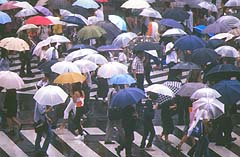 Frequent rain and hot summers are the two prominent features of Japan's climate. The high temperatures and humidity, well-suited to rice-growing, have had an important impact on agriculture. Average rainfall in Tokyo, for example, is 1,800 mm, nearly double the global average of 1,000 mm. The dry and wet seasons are not as distinct as in South-east Asia and other parts of the world, and precipitation ( rain and snow )is high year-round throughout the country. The intensity of rain is relatively strong and varies from season to season Tsuyu Frequent rain and hot summers are the two prominent features of Japan's climate. The high temperatures and humidity, well-suited to rice-growing, have had an important impact on agriculture. Average rainfall in Tokyo, for example, is 1,800 mm, nearly double the global average of 1,000 mm. The dry and wet seasons are not as distinct as in South-east Asia and other parts of the world, and precipitation ( rain and snow )is high year-round throughout the country. The intensity of rain is relatively strong and varies from season to season Tsuyu  ( also pronounced as baiu ) is the term used to refer to the fine, incessant rains of early summer and naga-ame to the long, steady rains of autumn. The typhoons of late August and September bring heavy, storm-blown rain. Rain can be the bearer of blessings as well as difficulty and disaster, as in the case of water shortages or destruction from typhoons. ( also pronounced as baiu ) is the term used to refer to the fine, incessant rains of early summer and naga-ame to the long, steady rains of autumn. The typhoons of late August and September bring heavy, storm-blown rain. Rain can be the bearer of blessings as well as difficulty and disaster, as in the case of water shortages or destruction from typhoons.
( Source: Ame no kotoba jiten [ Dictionary of Rain Words ], Kurashima Atsushi, ed., Kodansha, 2000. ) |
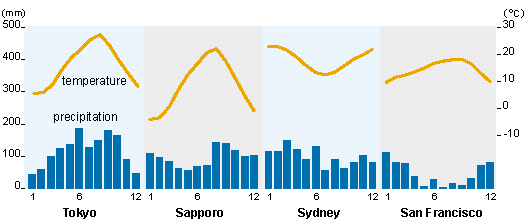 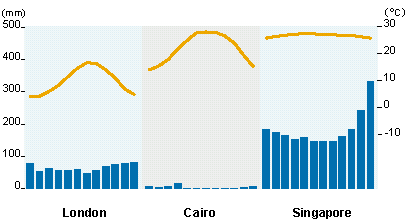 |
| Average monthly precipitation and temperature |
| ( Source: Rika nenpyoo 1999 nen [ Science Yearbook 1999 ] ) |
|
| The Language of Rain There are many words for rain in Japanese, each differing according to intensity, duration, and season. The same is true in warm, damp parts of China south of the Yangtze River. According to one theory, phenomena that play an important role in a given society and culture are often subdivided into various types and described using a wide variety of specialized terms. Often-cited examples are the rich vocabulary of the Inuit people* for snow and the Arab terminology for camels. Is the same true of rain in Japan? What sorts of phenomena in your country are expressed with such rich vocabularies? What role do those phenomena play in your culture? ( *See Language Thought and Reality, Benjamin Lee Whorf, John B. Carroll, ed., 1956) |
Kanji Characters with the Ame Radical
 The kanji characters used in Japanese are combinations of several parts. The kanji for many semantically related words share the same radical or part. Kumo The kanji characters used in Japanese are combinations of several parts. The kanji for many semantically related words share the same radical or part. Kumo  ( clouds ), kaminari ( clouds ), kaminari  ( lightning and thunder ), yuki ( lightning and thunder ), yuki  ( snow ), den ( snow ), den  ( electricity ) are several kanji relating to rain that have the ame radical. ( electricity ) are several kanji relating to rain that have the ame radical.
Kinds of Rain By intensity Ooame  ( (  big, big,  rain ): Heavy rain. When the rain is so heavy that flooding and other damage may result, the Meteorological Agency has established levels at which it issues official warnings or alarms to ward off possible disaster. rain ): Heavy rain. When the rain is so heavy that flooding and other damage may result, the Meteorological Agency has established levels at which it issues official warnings or alarms to ward off possible disaster.
By season / time of day Harusame  ( (  spring ): Gently falling, fine rain during the warm days of spring. spring ): Gently falling, fine rain during the warm days of spring.
Tsuyu  ( (  plum ): Rainy season lasting for about 30 days from around the 10th of June to the 10th of July. The rain that falls during this time of year. The term refers to the long rains that coincide with the season when the fruit of the plum trees ripen. ( Kara tsuyu: Dry spell resulting from predominantly clear weather during the usually rainy season.) plum ): Rainy season lasting for about 30 days from around the 10th of June to the 10th of July. The rain that falls during this time of year. The term refers to the long rains that coincide with the season when the fruit of the plum trees ripen. ( Kara tsuyu: Dry spell resulting from predominantly clear weather during the usually rainy season.)
Yuudachi  : Evening cloudburst or sudden showers of summer. Often accompanied by thunder and lightning. : Evening cloudburst or sudden showers of summer. Often accompanied by thunder and lightning.
By duration Toori-ame  : Sudden downpours that last only briefly, as if passing by quickly. : Sudden downpours that last only briefly, as if passing by quickly.
Naga-ame  ( (  long ): Rain, such as that of the early summer ( tsuyu ) and autumn seasons, that falls continuously for days on end. long ): Rain, such as that of the early summer ( tsuyu ) and autumn seasons, that falls continuously for days on end.
By characteristics Taifuu  : Of the tropical cyclones originating in the low latitudes in the northwest Pacific, the ones with wind velocity near their vortex reaching at least 17 meters per second are called taifuu. Several typhoons typically sweep over Japan during August and September, often wreaking widespread damage. ( Try thinking about how typhoons differ from or resemble hurricanes and cyclones.) : Of the tropical cyclones originating in the low latitudes in the northwest Pacific, the ones with wind velocity near their vortex reaching at least 17 meters per second are called taifuu. Several typhoons typically sweep over Japan during August and September, often wreaking widespread damage. ( Try thinking about how typhoons differ from or resemble hurricanes and cyclones.)
|
| Other Expressions | 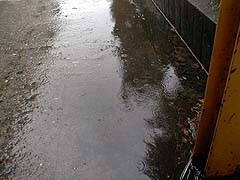 Photo: Kanaegaura Hight School Photography Club |
Ame futte ji katamaru  : This phrase suggests how, just as the earth settles more solidly in a landfill after a rain, understanding can often be reached after a certain amount of turmoil and argument has taken place. : This phrase suggests how, just as the earth settles more solidly in a landfill after a rain, understanding can often be reached after a certain amount of turmoil and argument has taken place.
Ame onna / ame otoko  / /  : Name for someone whose presence always seems to be accompanied by rain or bad weather. The opposite expressions, for those who seem to bring good weather, are hare onna / hare otoko. : Name for someone whose presence always seems to be accompanied by rain or bad weather. The opposite expressions, for those who seem to bring good weather, are hare onna / hare otoko.
|
|
| Living with the Local Climate | |
|
Housing Traditional-style dwellings feature various devices for coping with local climate. Dwellings of old Japan built of wood, which absorbs moisture, were well suited to its humid climate. In regions swept by strong gales, people built windbreaks around their houses and in the coastal areas they protected their houses from sea winds with stone walls. In regions with heavy snowfall, the houses were built with steep roofs to prevent heavy accumulation of snow and extra strong posts to withstand the weight of snow. What sort of characteristics do houses display as a reflection of the climate in your region? |
|
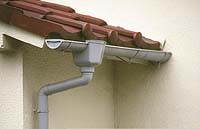 |
Amadoi  Eaves troughs for draining water from the roof and channeling it to the ground or into drains. |
|
Umbrellas | |
|
According to a survey conducted in 1993, Japanese own an average of 7 umbrellas per person and annual demand for umbrellas was 100 million. For people who live in a country with as
much rain as Japan, umbrellas are indispensable. ( Source: Ame no kotoba jiten )  ). ).Oki-gasa  : Sometimes, even though it was clear in the morning, it will start raining in the middle of the day. For times like these, many people keep an extra umbrella at school or workplace, called an oki-gasa. : Sometimes, even though it was clear in the morning, it will start raining in the middle of the day. For times like these, many people keep an extra umbrella at school or workplace, called an oki-gasa. Ori-tatami gasa Ori-tatami gasa  : Collapsable umbrellas are sold in large numbers. In uncertain weather, it can be bothersome to carry a bulky full-length umbrella. When you can't be sure whether it will rain or not, it is always reassuring to have a foldable umbrella in your bag or briefcase. Recently very light-weight folding umbrellas have been designed that weigh as little as 100 grams. : Collapsable umbrellas are sold in large numbers. In uncertain weather, it can be bothersome to carry a bulky full-length umbrella. When you can't be sure whether it will rain or not, it is always reassuring to have a foldable umbrella in your bag or briefcase. Recently very light-weight folding umbrellas have been designed that weigh as little as 100 grams.Kasa-tate  : Most homes as well as entrances to public buildings have umbrella stands. In public places the umbrella stands are usually brought out specially when it starts raining. One might worry that one's umbrella might be stolen while inside the building, but in most cases, one need not worry. Of course, some do go missing when many people gather in one place. In some cases, such as hotels and museums, the umbrella stands have locks with removable keys. Supermarkets and department stores generally encourage patrons to carry their umbrellas with them into the store, providing plastic bags at the entrance to prevent dripping. : Most homes as well as entrances to public buildings have umbrella stands. In public places the umbrella stands are usually brought out specially when it starts raining. One might worry that one's umbrella might be stolen while inside the building, but in most cases, one need not worry. Of course, some do go missing when many people gather in one place. In some cases, such as hotels and museums, the umbrella stands have locks with removable keys. Supermarkets and department stores generally encourage patrons to carry their umbrellas with them into the store, providing plastic bags at the entrance to prevent dripping. 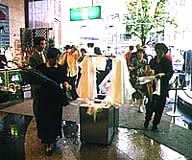 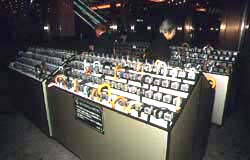 | |
Aiai-gasa  : "Two under the same umbrella" is associated with couples in love. A simple sketch like that at right, showing the names of the pair, means "Moriyoshi and Noriko like each other." : "Two under the same umbrella" is associated with couples in love. A simple sketch like that at right, showing the names of the pair, means "Moriyoshi and Noriko like each other." |
  |
|
Tomorrow's Weather | |
Tenki yohoo  : The weather report is an inseparable part of daily news broadcasts. It is also possible to get up-to-date Meteorological Agency reports on the weather by telephone by dialing 177. Today the accuracy of weather reports is roughly 80 percent. : The weather report is an inseparable part of daily news broadcasts. It is also possible to get up-to-date Meteorological Agency reports on the weather by telephone by dialing 177. Today the accuracy of weather reports is roughly 80 percent.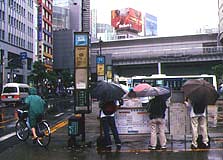 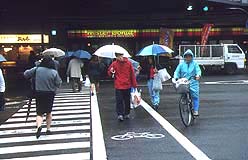 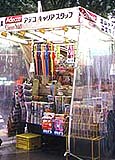 |
|
Teru-teru boozu  : The night before a school excursion, it looks like rain ... The plans for such events usually call for "postponed in case of rain" ( uten enki : The night before a school excursion, it looks like rain ... The plans for such events usually call for "postponed in case of rain" ( uten enki  ) ( the opposite is "going ahead even in case of rain" [ uten kekkoo ) ( the opposite is "going ahead even in case of rain" [ uten kekkoo  ]). No one wants to wake up to find it is raining on the day of a much-anticipated outing. What would you do on such a day? In Japan, we still see little children making "fair-weather" dolls called teru-teru boozu and hang them outside the window. There is even a song to go along with them. ]). No one wants to wake up to find it is raining on the day of a much-anticipated outing. What would you do on such a day? In Japan, we still see little children making "fair-weather" dolls called teru-teru boozu and hang them outside the window. There is even a song to go along with them. |
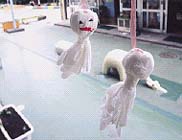 Photo: Nakanishi Yusuke |
|
| Society Water shortages: Low precipitation during what are normally rainy seasons and prolonged hot spells interrupt the normal rhythms of daily life. In the summer of 1994, for example, temperatures reached record highs and rainfall fell far below the yearly average. Reservoirs nearly dried up and water was in short supply all over the country. Strict regulation of the water supply was begun, prohibiting use of water for pools and fountains, and people started buying bottled water to drink. The damage to farm crops was widespread and in some areas of the country the staple of school lunches was switched from boiled rice to bread and from use of fresh-cooked ingredients to water-conserving frozen foods and canned goods. They even changed from the usual eating utensils to throw-away paper dishes and cups that would not have to be washed. The impact that fluctuations in the weather can have on society has helped to arouse new awareness of the importance of efficient use and conservation of rain water. Goou  : Figures given in the Rika nenpyo [ Science Yearbook ] for 1997 state that goou according to the definition of the Meteorological Agency has occured nine times since 1957. Each of these instances resulted in damage to crops and dwellings and from several dozen to several hundred people perished. Torrential rains accompanying typhoons passing through metropolitan areas like
Tokyo can paralyze public transportation networks and cause damage to urban utility systems. The culture and civilization developed by the advanced industrial society is in some aspects quite vulnerable to the effects of natural disasters. : Figures given in the Rika nenpyo [ Science Yearbook ] for 1997 state that goou according to the definition of the Meteorological Agency has occured nine times since 1957. Each of these instances resulted in damage to crops and dwellings and from several dozen to several hundred people perished. Torrential rains accompanying typhoons passing through metropolitan areas like
Tokyo can paralyze public transportation networks and cause damage to urban utility systems. The culture and civilization developed by the advanced industrial society is in some aspects quite vulnerable to the effects of natural disasters.Sansei-u  : Acid rain. Rain with a hydrogen ion index of 5.6 points or less. Acid rain has 10 times more hydrogen ions than normal rain, which can seriously damage soil, forests, as well as wetlands. It is believed that automobile exhaust is the cause of acid rain, which is a global problem. : Acid rain. Rain with a hydrogen ion index of 5.6 points or less. Acid rain has 10 times more hydrogen ions than normal rain, which can seriously damage soil, forests, as well as wetlands. It is believed that automobile exhaust is the cause of acid rain, which is a global problem.The weather is an intimate part of people's daily life and moods. It is mentioned frequently in myths and folk tales, novels and stories, fairy tales, songs, and other literary works. Weather often figures in the plot of films and other works. What part does weather play in the life of your country? |
Activities
| ||||||
| 1. Examine the onomatopoeic words related to rain below. What characteristics of rain do you think they express? Link the word to the appropriate picture. | 2. What other onomatopoeic words could we use? Try imagining various natural phenomena and creating onomatopoeia to describe them. | |||||
 Potsu-potsu ・ Potsu-potsu ・ |
・ |  |
|
|||
 Shito-shito ・ Shito-shito ・ |
・ |  |
||||
 Zaa-zaa ・ Zaa-zaa ・ |
・ |  |
||||
* The naming of a thing or action by a vocal imitation of the sound associated with it ( as buzz, hiss). | ||||||
| ||||
| Using the weather symbols below, describe the climate of your area, or use them to describe an event or feeling associated with a certain kind of weather. |
Sample sentences :    |
|||
  hare clear |
  kumori cloudy |
  ame rain |
  kaminari thunder and lightning |
  kumori, nochi ame cloudy, followed by rain |
  hare tokidoki ame clear, sometimes rain |
  yuki snow |
| ||
|
What would you do in the following situations: * Times when you want it to be good weather tomorrow * When it suddenly begins to rain * When you want to know what the weather will be the following day |
| ||||
|
1. Study the diagram (click here) and answer the questions. (1) In each city, during what month of the year is precipitation highest? What month is it lowest? | ||||
 Month of highest precipitation |
 Month of lowest precipitation |
|
|
| ||
 |
||
 |
||
 |
||
 |
||
 |
||
 |
||
 |
||
 |
||
(2) In Tokyo, it rains a great deal in June.  Why is that? ( click here ). Why is that? ( click here ).2. Answer the following questions: (1) What kind of umbrella do you use most often, a large umbrella or a folding umbrella? Why do you think folding umbrellas are used so often in Japan? (2) What is a common color of umbrellas and raincoats for small children in Japan? What do you think is the reason for that? (3) List some of the words used to express rain in English. List words used to describe other kinds of weather. (4) List the names of some products / items of daily use that are related to the particular climate of your country or region. Why are such items used so often? (5) Explain some of the customs related to the weather that are part of your daily life. What kind of customs are they? When are they practiced? Where? What do you think the reasons are for such customs? |
Original text : The Japan Forum Newsletter no19 "A day in The Life" December 2000.
Send feedback to forum@tjf.or.jp